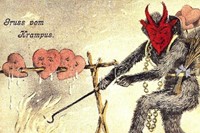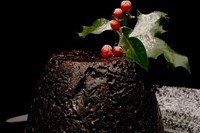As we start to put our own Christmas traditions into practice (and with Christmas day just one week away), we've taken the opportunity to bring you some of our favourite lesser-known Christmas traditions from across the globe...
Christmas wouldn't be the same without its accompanying traditions. In Britain these range from the rudimentary – advent calendars, mulled wine, mince pies, tangerines and Christmas stockings – to the more specific family traditions like the annual playing of a certain game, the allotted time for present opening and the prized decoration chosen to top the Christmas tree.
Now, as we start to put our own traditions into practice (and with Christmas day just one week away), we've taken the opportunity to bring you some of our favourite lesser-known Christmas traditions from across the globe...
Austria... Austrian Santa Claus has a notoriously evil twin named Krampus Night whose job it is to punish children who have misbehaved. On December 6 of each year, men dress up in terrifying devilish costumes and run through the streets swiping at people with sticks and switches. The Krampus legend originated in the Germanic alpine region and is also popular in Hungary, Bavaria and Slovenia.
Czech Republic... On Christmas Eve, unmarried Czech women carry out an annual tradition to predict their relationship status for the forthcoming year. Standing with their backs to a door, they toss one of their shoes over their shoulder. If, when it lands, the toe faces the door, the thrower will marry within the year but if the heel faces the door, they will remain unmarried for another year.
Japan... For many Japanese, the traditional Christmas dinner consists of Kentucky Fried Chicken. So popular and well-marketed is the concept that most KFC restaurants accept reservations on Christmas day.
"For many Japanese, the traditional Christmas dinner consists of Kentucky Fried Chicken"
Norway... Norwegian legend has it that hoards of witches and evil spirits come out on Christmas Eve searching for brooms to ride on. Thus, to this day, Norwegian women traditionally hide their brooms, mops and brushes from sight on Christmas Eve, while men sometimes fire a shotgun outside the house to scare the witches away.
Spain, Portugal and Italy... In parts of Spain, Portugal and Italy it is tradition to set up a model village of Bethlehem and the nativity scene. This includes the usual Christmas figurines – baby Jesus, Mary and Joseph et al – but more unusual is the inclusion of the so-called "caganer." This is a man in the act of defacating, knees bent, often accompanied by the fruits of his labour and positioned in a discreet corner. The placement of this uninhibited and controversial figure in the crèche is a counterpoint which adds a human side to the representation of the mystery of Christmas. The caganer is originally a Catalan tradition and is thought to date back to the late 1700s.
Sweden... For over 40 years, the Swedish town of Gävle has erected a giant straw goat to mark the beginning of the holiday season. But every year vandals compete to burn down the goat before Christmas day in what has become the key part of the tradition. Typically contenders disguise themselves as Santa Claus or elves and attempt to sneak past the goat's guardians to ignite it. Since 1966, the straw goat has survived until Christmas day just 10 times.
"In the Venezuelan capital of Caracas, Catholic churchgoers attend the routine early morning mass on rollerskates"
United Kingdom... On our part, the Christmas pudding – an integral part of the Christmas meal – is one of the most idiosyncratic British traditions. The age-old belief is that the pudding maker will be granted a wish, providing it is made while they mix the ingredients in a clockwise direction. Equally, many place a silver coin in the pudding mixture wich is said to bring luck to the person that finds it.
Ukraine and Slovakia... Traditionally, the commencement of Ukrainian and Slovakian Christmas dinner is marked by the family patriarch throwing a spoonful of "didukh" (a dish made of fine wheat paste) at the ceiling. The amount of food that sticks to its target is said to be directly proportional to the crop growth of the year ahead.
Venezuela... In the Venezuelan capital of Caracas, Catholic churchgoers attend the routine early morning mass between 16th and 24th of December. What is less routine however is their method of transport to and from the church: rollerskates. The streets are pedestrianised until 8am each day and it is traditional for children to tie a piece of string to their toe each night, hanging the other end out of their window for the passing rollerskaters to tug the next morning.
Text by Daisy Woodward
Research by Jane Fayle



